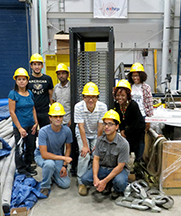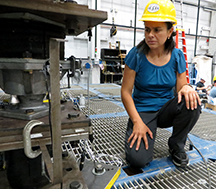August 28, 2014
Study shows local seismic isolation and damping methods provide optimal protection for essential computing equipment
 |
|
Howard University professor Claudia Marin-Artieda at the NEES at Buffalo laboratory with her research team and the "Yahoo frame." With 40 servers installed, the frame was shaken with servers in partial operation to monitor their functionality under earthquake shaking. From left are Marin-Artieda, Pedro Calado, Amedebrhan Asfaw, Pedro Reshsteiner, Xing Han, Diego Buitrago, Paquilla Jones and Sajeeda Chin. |
BUFFALO, NEW YORK – In experiments aimed at securing essential electronic equipment, a team of researchers led by earthquake engineer Claudia Marin-Artieda is seeking solutions for protecting computer servers, backup power units, and other high-tech equipment by employing locally installed passive seismic protective systems, such as base isolation and damping.
Base isolation is a technique that sets objects atop an energy-absorbing base; damping employs energy-absorbing devices within the object to be protected from an earthquake's damaging effects.
The case study tests are being conducted at the State University of New York at Buffalo earthquake engineering lab, a research facility managed by the George E. Brown Jr. Network for Earthquake Engineering Simulation (NEES), a shared network of laboratories based at Purdue University.
"The loss of functionality of essential equipment and components can have a disastrous impact. We can limit these sorts of equipment losses by improving their seismic performance," said Marin-Artieda, associate professor of civil engineering at Howard University.
The experiments used different devices for supporting the equipment and components that are being subjected to simulated earthquake shaking on a building's floors; the data generated provides basic knowledge for design engineers as well as for companies and institutions that manage critical equipment operations.
Marin-Artieda's research is funded by an NSF Career Award to investigate seismic protection systems for equipment and components in multistory essential facilities that include data centers and computer-based communication centers.
 |
|
Howard University professor Claudia Marin-Artieda is shown with an elastomeric bearing atop a universal hinge. Experimental results indicate that this system may be a good candidate for protecting heavy equipment. |
Initial findings were discussed in a paper presented during Quake Summit 2014, part of the Tenth National Conference on Earthquake Engineering, last month in Anchorage, Alaska.
Specifically, the preliminary work confirmed that globally and locally installed seismic isolation and damping systems can significantly reduce damage to essential equipment and components (EEC) in the event of an earthquake.
In critical buildings such as data centers, power plants and hospitals, it could be catastrophic to have delicate, highly sensitive equipment swinging, rocking, falling and generally bashing into things. In high-seismic regions, new facilities often are engineered with passive protective systems (PPS) that provide overall seismic protection. But often, existing essential facilities are conventional fixed-base buildings in which seismic demands on sensitive equipment located within are significantly amplified; in such buildings, sensitive equipment needs to be secured from these damaging earthquake effects.
The stiffer the building, the greater the magnification of seismic effects.
"It is like when you are riding a rollercoaster," Marin-Artieda said. "If your body is relaxed, you don't feel strong inertial effects. But if you hold your body rigid, you'll feel the inertial effects much more, and you'll get knocked about in the car.
"That is why it is important to secure the EECs themselves. But local protection for high-tech equipment has been limited. Designing passive protection systems for EECs is complex. The components come in a variety of shapes, sizes and weights, and they have varied dynamic properties, as well as various locations in a building - which all, in turn, depend on the unique types of three-directional ground shaking earthquakes subject them to."
Marin-Artieda and her team conducted real-time, full-scale tests to examine the efficacy of isolation and energy dissipation devices such as platforms, floors and individual systems for protecting different types of equipment sets.
The ultimate goal of the research is to design devices that protect specific EEC systems and to discover the least vulnerable areas of multistory buildings for housing EECs.
For the experiments, Yahoo Labs donated 40 computer servers in a frame, or rack. All 40 servers were attached to the frame in multiple configurations, on seismically isolated platforms, and were subjected to a variety of three-directional ground motions. The "Yahoo frame" was shaken with the servers in partial operation to monitor the functionality of the servers under earthquake shaking.
In addition, the project has partial support from other industry partners providing in-kind materials for the experiments, including Seismic Foundation Control Inc., The VMC Group, Minus K Technology Inc., Base Isolation of Alaska, and Roush Industries Inc.
The team observed and recorded the optimal characteristics of the protective options for EECs they tested, as well as the interaction of seismic protective options and the effects of floor accelerations on the response of sensitive equipment and their protective measures. The experiments a 6-degrees of freedom shake table also have validated the passive-system arrangements designed by Marin-Artieda and her team.
Different protective measures can be defined based on the equipment characteristics; however, for seismic displacement control, supplemental damping for energy dissipation is essential in all protective measures. The experimental studies of frames holding servers and other simulated equipment supported on different wire ropes sets were performed. The wire ropes used in the tests were donated by the VMC Group. Wire ropes traditionally are used for vibration isolation since they can provide vertical isolation. Wire ropes dissipate energy by rubbing and friction between the components of the wire ropes. Additionally, some energy dissipation foams were inserted within the wire ropes to increase the system's damping properties.
The underlying wire rope platform may be seen in action in this video clip. Another camera angle shows the Yahoo frame being shaken atop the wire rope platform.
In these studies, five different sets of wire ropes were tested under different equipment configurations and different payload levels. The experimental studies included shear/roll and 45-degree configurations of the wire ropes. The preliminary experimental results confirmed that supplemental damping is essential for reducing seismic effects of tall frames holding equipment.
Flexibility of the protective interface is fundamental in the protection of acceleration-sensitive equipment. The studies included different isolation platforms to provide a flexible interface to the equipment to reduce the transmission of seismic accelerations.
One of these platforms was supported on four seismic isolators, shown in this video clip. Each isolator consists of an elastomeric bearing atop of a hinge joint. The hinge joint acts as an articulation connecting the elastomeric bearing and the floor. The hinge provides additional flexibility to the overall system and releases seismic tensile stresses on the elastomeric bearing. Experimental results indicate that the system may be a good candidate for protecting relatively heavy equipment. This isolation system was developed by Seismic Foundation Control Inc.
Other platforms with flexible interfaces were tested, including a commercially available vibration isolation platform based on arrangements of negative springs to achieve three-directional isolation and developed by Minus K Technology Inc. In addition, a lead-rubber-bearing-supported platform, developed by Xing Han, a post-doctoral associate from the Department of Civil and Environmental Engineering at Howard University, was tested.
For Marin-Artieda, future research includes the development of a framework for analysis, design and implementation of the protective measures. She plans to undertake the following studies: 1) developing enhanced analytical and numerical modeling tools of protective measures; 2) exploring simplified but robust design procedures able to capture the main components in the equipment and protective measures; and 3) examining the overall design and implementation process of the equipment-protective measure.
Overall, experimental results with platforms with a flexible interfaces were able to reduce significantly ground and floor accelerations transmitted to the equipment. Shake table tests demonstrated that installing local seismic isolation and damping methods can significantly lessen the seismic responses of equipment at different floor levels within fixed-base buildings.
Media Contact, Purdue University: Marti LaChance, 765-496-3014, lachance@purdue.edu
Media Contact, SUNY at Buffalo: Cory Nealon, cmnealon@buffalo.edu
Source: Claudia Marin-Artieda, 202-806-6580, cmarin@howard.edu
ABSTRACT
Case Studies on the Seismic Protection of Equipment in Essential Buildings
C.C. Marin-Artieda, Associate Professor, Dept. of Civil and Environmental Engineering, Howard University, Washington, D.C.
This paper summarizes the initial developments of a research program that is underway to evaluate the efficacy of passive settings to seismically protect sets and pieces of equipment of essential facilities. Specifically, this paper presents case studies based on detailed numerical analysis using models that were validated with available experimental data. The case studies confirmed that: 1) amplification of accelerations in the upper floors of fixed base buildings strongly depends on the modal characteristics of the building and are independent of the type of ground motion; 2) on a base isolated building, the responses of equipment with relatively short fundamental period depend on the frequency content of the ground motions; in contrast, the responses of equipment with relatively long fundamental period depend on the dynamic properties of the base isolated building; 3) acceleration responses of top floors on stiff fixed base buildings suggest potential tuning of equipment in a narrow period band, near the fundamental period of the building. The latter observation suggests potential for reduction of acceleration responses on roof (or upper floors) equipment by lengthening the fundamental period of the piece of equipment to detune the equipment from the resonant period of the building; 4) the benefits of seismic isolation and damping reducing significantly the seismic responses of equipment at different floor levels on a fixed base building.
